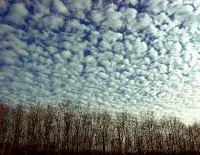 Clouds are all interesting things if you take some time to think about them. We know that they contain water droplets because they bring rain. But, did you know that they exist in liquid and ice forms?. And..
Clouds are all interesting things if you take some time to think about them. We know that they contain water droplets because they bring rain. But, did you know that they exist in liquid and ice forms?. And..What keeps the Clouds up there?
Water droplets are obviously heavier than air. So, why don't Clouds fall out of the sky?
1. In fact, clouds do fall down. But, because the droplets and crystals are microscopic, they face a significant air drag against their fall so that they fall at very low speeds. From earth, their fall is almost unseen.
2. Water droplets are constantly being formed and re-evaporated within the clouds, countering the fall of droplets due to gravity. Especially when Warmer air is present beneath the clouds.
3. In addition, air currents and winds affect the motion of clouds and help to keep them from falling.
White Clouds and Dark Clouds
Tiny droplets of water are densely packed in clouds. These droplets reflect out sunlight and gives rise to white colored appearance.
However, when these droplets coalesce producing larger drops, space between them increases. This allows sunlight to pass much deeper into the cloud before being reflected. Since water does absorb some wavelengths, the cloud appears grayish. Bigger the cloud, darker it appears.
Types of Clouds
Clouds are popularly classified based on their physical appearance and altitude.
Based on structure, we have 2 basic formations;
1. Cumulo
Heap-like formation
2. Strato
Layer-like formation
High-level Clouds
At these heights, air is cold that droplets exist as tiny ice crystals and these clouds are packed much less densely.
these clouds are given the prefix "cirro-"
Basic Types
Cirrus
Thin, Feathery loosely formed clouds
Cirrostratus
Layered appearance.
Cirrocumulus
Clustered appearance
Cirrus
 |
| Cirrocumulus clouds |
Cirrostratus
Layered appearance.
Cirrocumulus
Clustered appearance
Mid-level Clouds
between 2km to 6km
these are prefixed "alto-"
Basic Types
Altostratus
Flat, uniform texture
Altocumulus
Clumps and heaps
Low-level Clouds
below 2km
these clouds are not given a prefix.
Basic Types
extends horizontally
Cumulus
extends vertically
Stratocumulus
significantly exhibits both horizontal and vertical distributions
Rain clouds
The term 'Nimbo' is used to refer to rain clouds.
Nimbostratus
Cumulonimbus
Cumulus appearance. These give heavy rains and thunderstorms
Fog
Fog is actually a layer of stratus clouds close to ground. So, its the closest thing we can see study by ourselves. Fog does fall away with time. So, its almost the same up there..
Conclusion
Clouds are one of the most amazing and dynamic structures ever seen by a person on Earth. Analyzing them allows to have a better understanding and forecasting of nearby events. Study of clouds take place as 'Cloud Physics' and 'Nephology'. These studies are valuable for the better understanding of atmospheric conditions and weather changes.Reference
http://www.crh.noaa.gov/lmk/?n=cloud_classification
http://en.wikipedia.org/wiki/Cloud




Post a Comment